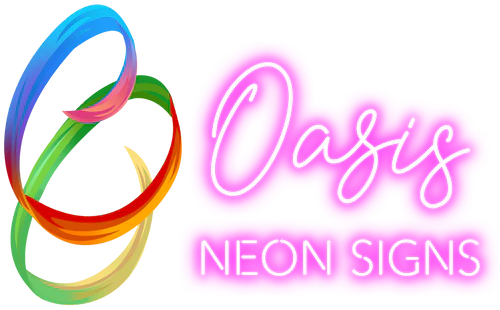
Neon vs LED: Difference Between Neon Signs and LED Signs
Share
When considering signs for use in advertising, decoration, or ambiance, two common choices are neon signs and LED signs. Both varieties of signs have distinct characteristics, advantages, and proper applications. Neon signs are considered more vintage and nostalgic, whereas LED signs are respected for their energy efficiency and versatility. To help you make up your mind on the types of signs that are best suited for your needs, one needs to know the main differences between neon and LED signs.
1. Technology Behind Neon and LED Signs
Neon Signs: Neon signs are made using a gas-discharge process. The glass tubing is filled with a noble gas, and when bent to letters or designs and a high-voltage current runs through the gas, bright, eye-catching colours result. Neon signs are well-known for their brilliant glow colours that may include red, orange, blue, and green.
LED Signs: LED means Light Emitting Diode. These signs are built using semiconductor technology that gets its illumination when an electric current passes through it. LED lights are produced in a range of colours, and their emissions are more energy-efficient compared to traditional sources of illumination. LED signs have also found use in digital displays or dynamic signage, rendering them highly versatile. With the advanced LUMINEX LED neon technologies, businesses and designers can take full advantage of these energy-efficient, vibrant, and versatile LED signs to create custom lighting solutions that stand out in any setting.
2. Energy Efficiency
Neon Signs: Significantly higher they permit greater energy consumption than LED signs. A transformer also converts the electrical current into a higher voltage. All this may lead then to higher energy consumption and history growing electricity bills, especially if left on for long periods.
LED Signs: LED is a more efficient type of signage. They want only a fraction of energy compared to neon to yield an equivocal or brighter output. This feature adds to the lower cost of ownership for them in the long term compared to neon signs for business owners who want to keep their lights on for longer.
3. Durability and Lifespan
Neon Signs: Neon signs consist of fragile glass tubes that get easily broken or damaged during handling or transportation. With time, the glass might become loose in one place or another, causing a small amount of the gas inside the neons to leak. In whatever respect, neon signs have a shelf life ranging from anywhere between 8 to 15 years when well-kept. However, their fragility necessitates that they are on an ongoing maintenance schedule.
LED Signs: LED lights are duly resistant to falling and also more durable when it comes to physical issues as opposed to neon glass tubes. They are solid-state lights, meaning they are not prone to physical damage like that of neon glass tubes. Life expectancy can go as high as 50,000 hours. In a long-term outlook, this will go a long way in making LED signs more dependable and low-maintenance.
While the lifespan of neon signs typically ranges from 8 to 15 years with proper care, their fragile glass construction makes them more prone to damage. In contrast, LED signs are far more durable and long-lasting, offering a low-maintenance solution that can operate for tens of thousands of hours.
4. Brightness and Visibility
Neon Signs: Neon signs have a faint soft glimmer look; therefore, they preserve their classic vintage appeal. They are bright and visible; however, such a shine might be diffused, and in comparison, to LED lights, this is bland from a distance. Indoor climates or spaces with low ambient lighting resonate better with neon signs.
LED Signs: An LED sign has good clarity and brightness. The fierce and sharp displays make it useful for inside and outside locations. These are visible from long distances against bright backgrounds, both daytime and nighttime. Such displays are specifically effective for grabbing attention in busy or brightly lit environments.
5. Design Flexibility

Neon Signs: Neon signs are anything but flexible regarding their design. Their complexity can call for extensive man-hours and equally enormous manufacturing times. They are still static signs since there is no such animal as dynamic content.
LED Signs: As any LED-based design is much more flexible, LEDs can fit apart from being different in shape and size. The fact that LED signs are compatible with animations or even programmable messages makes them good for everything, from T ads to interactive displays. Thus, with LED technology, designs are limited only by our imagination.
6. Environmental Impact
Neon Signs: However, neon signs are not so eco-friendly as neon gas and glass tube fabrication waste some resources. Neon lights also contain mercury in large amounts, which is highly detrimental to nature.
LED Signs: On the contrary, LED lighting is way more eco-friendly than neon lighting. They use less power; thus, making the life span more, containing absolutely no harmful substances like mercury. The LEDs are 100% recyclable, which adds to not only their benefits but saves the environment too. It is for this reason that the LED signs facilitate a jump from traditional advertising to modern sustainability.
The environmental impact of neon signs is higher due to their use of mercury and resource-intensive materials, making them less sustainable. In contrast, LED signs are energy-efficient, mercury-free, and fully recyclable, making them a more eco-friendly option for businesses aiming to reduce their carbon footprint.
7. Cost Comparison
Neon Signs: As for maintenance costs, neon signs are more expensive than LED signs. This stems from glass moulding being extremely pricey. Adding on, high-voltage transformers are expensive. Neon also requires routine support and maintenance.
LED Signs: Even though the manufacturing price of LED signs varies in complexity and dimension, it’s apparent that the investment for LED signs is most effective in the long haul. This is because signs like those are lower maintainable throughout the years while requiring little electricity for powering. Although it seems, from the perspective of a business, LEDs are long-lasting.
8. Maintenance and Repair
Neon Signs: More expensive than LED signs due to costly gas leakage and potential cracking of the glass tubes; therefore, maintenance is necessary. Repairing or replacing a broken neon sign can be costly and usually needs a professional to do the job. With regular maintenance, care, and service, a neon sign can survive quite long in good repair.
LED signs: Little maintenance is involved; a technician repairs any that's damaged, and this happens very rarely. In most cases, only one LED bulb or one of its components needs to be replaced. This is easier on the pocketbook than replacing the entire sign. Having a long lifespan and durability means less maintenance and fewer repairs are needed.
9. Aesthetic Appeal
Neon Signs: With its throwback appeal, neon evokes fond memories. Neon glows with a warm and inviting feeling, sure to enhance any space's ambience. Bright, colourful, retro, and vintage neon is quite popular with bars and restaurants or any business wishing to create a unique and enticing atmosphere.
LED Signs: LED signs may appear alternate even original; however, many feel they lack the charisma associated with neon lights. It is worth mentioning that LED technology has grown tremendously, allowing the manufacture of signage that imitates neon with flexible LED strips to produce a similar glowing effect. The LED sign generally is more versatile concerning design; furthermore, they melt into many modern or futuristic surroundings.
10. Applications

Neon Signs: Neon signs, as a general rule, are used by businesses or places that aim to create a retro feeling of nostalgia. They can usually be found in places like bars, restaurants, storefronts, and along main streets, where visibility is important. Neon is also widely used in art installations, artistic lighting, and sometimes decorative work.
LED Signs: Since LED signs are variously customizable, they can fit a wide range of uses and settings. They could almost be branded a good candidate for dynamic digital displays, billboards, street signs, and even sports arena scoreboards. These signs can alter messages and introduce animation, which renders them a common choice for advertising.
Conclusion
Ultimately, the specifications of your project, the impact you want to make, and your budget will determine whether you would go for a neon or an LED sign. Neon gives a vintage retro touch with a mesmerizing character and adds warmth to a place; however, they tend to consume much more energy and require maintenance care since they are first-generation technology. LED signs tend to be modern, energy-efficient, and highly customizable; fluorescent lighting accommodates probably any kind of use case.
Of course, for people with a tight budget who seek more environmentally friendly, durable, and inexpensive signage solutions, LED signs will probably be the preferred option. Neon at least is available for those who crave that old-world attraction of those coloured, glowing signs. Ultimately, your considerations will include the function, location, and budget.

